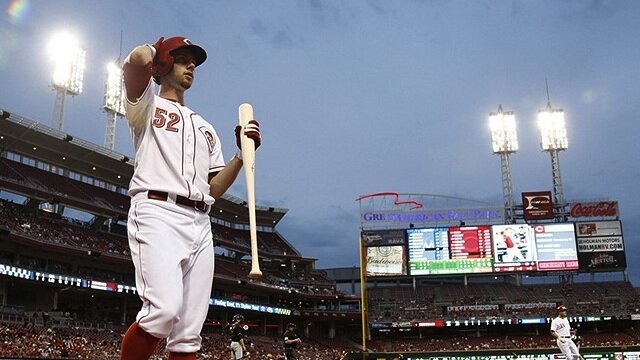It’s pretty impressive when a pitcher in the minor leagues can throw a fastball 85% of the time and still be successful. A lot of pitchers hover around the 50% mark, others the 70% mark, but most are right around 60%. There’s a cliché that references major leaguers’ ability to hit fastballs, no matter how fast — you might get away with overpowering MPHs in lower levels, but not once you hit the Show. After all, all your other pitches work off of your fastball. If there was no fastball, your change-up would ultimately just be a slow fastball. Hitting is timing, and pitching is throwing off that timing — you know that.
This is why Cincinnati Reds SP Tony Cingrani‘s success is so weird. Context: after throwing his heater over 85% of the time this year in the minors, Cingrani threw 83 fastballs in 102 pitches on his season debut on Thursday vs. the Miami Marlins — 81%. He threw 11 slider-curves and eight change-ups. Of his eight strikeouts, six of them came from fastballs and two of them from the slider-curve.
While watching the game, I noticed Cingrani’s propensity to (or Devin Mesoraco‘s pitch-calling propensity) throw the high heat with two strikes. It was almost unfaltering and it worked. After reviewing the replay, five of eight Cingrani strikeouts came on a high fastball out of the zone, one on a broadway fastball that should’ve been mashed, and two on low slider-curves. After a while you noticed the Miami hitters expecting the two-strike high fastball, and a few of them were able to get on top of it and drive it. And when Cingrani switched it up, his off-speed wasn’t always effective enough to throw them off.
For Cingrani to continue to effectively throw his straight, high fastball for strikeouts via deception and an awkward release point, he’ll need to continue to improve his slider-curve until it becomes an effective secondary K pitch, and will need to off-set the two with the change-up. For the longer-run, he’ll probably need to add a fourth pitch.
Also, Cingrani’s command wasn’t totally there: He walked three hitters over five innings and saw two 3-0 counts — a recipe for disaster when you’re already throwing 83% fastballs.
If Cingrani continues to fall behind hitters and battle in counts his success will be short-lived. Hitters know how much he loves to throw his fastball, and, it’s assured, they’ll learn to hit it. Without a reliable pitch other than his fastball that he can throw in a hitter’s count, Cingrani’s fastball will start to get lit up; the disadvantage of a 2-0 count will be exacerbated.
This was all Miami’s lineup, too, which we all know might be the worst lineup in the MLB.
If you are a Cingrani owner, I’d try and sell as soon as possible. The eye test, despite his final line, didn’t exactly meet up with his 2013 minor league stats and it’s a bit disconcerting. Also, don’t forget, when Johnny Cueto returns, Cingrani will probably lose his MLB rotation spot and be sent back down. Dusty Baker hates his youngin’s.
Follow Nick Tom on Twitter or +1 him on Google








